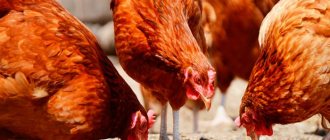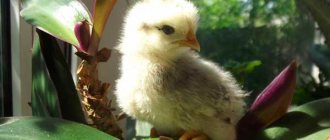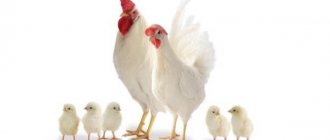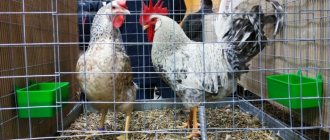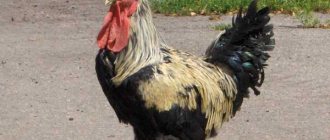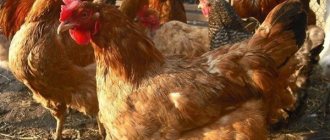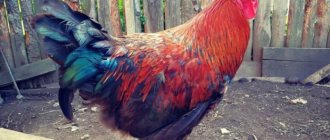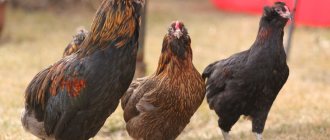How did the cross appear?
This hybrid appeared thanks to scientists from the company H&N International, located in Germany, but with many subsidiaries around the world. This company has managed to develop many popular hybrids with high performance and profitability.
Super Nick chickens are crosses intended for commercial breeding. The painstaking work of scientists contributed to obtaining excellent user qualities, and the hybrid became popular not only among owners of large poultry farms, but also ordinary farmers and summer residents who keep birds exclusively for personal consumption of products.
This cross was brought to Russia not so long ago - in 2005. Since then, it has been very popular; farmers value chickens for their external qualities, excellent taste of meat, and good performance.
Pros and cons of a hybrid, buying chickens
As for the disadvantages of cross-breeding, these are, first of all, a short period of effective egg laying and the need to frequently change the herd. This also includes some difficulties in keeping birds.
The advantages of the cross outweigh its disadvantages. The main advantages of these chickens are unpretentiousness, “precocity”, high productivity and profitability - the costs are quickly recouped and the farmer receives a net income.
When purchasing Super Nick chickens, be sure to carefully inspect them. One of the main signs for culling this cross is the presence of specks of a different color on its white plumage, the appearance of one or more dark feathers in the chicken’s “fur coat.”
A violation of the white color of the chicken indicates that this is a representative of a new (second) generation of cross with reduced productivity. Also, you should not buy a bird that has fluffy feathers on its body. They should be smooth and adjacent to the body.
If you liked the article, please like and repost on social networks so that your friends can see it. Write your opinion about hybrids in the comments.
External data and character
Externally, the cross is unremarkable, but if its inherent traits are absent, the bird is discarded. The characteristic features of the final Super Nick cross are:
- proportional triangular body of small size;
- the plumage is smooth, white;
- the chest is rounded, the back is small;
- a medium-sized head located on a short, thin neck;
- light red leaf-shaped comb, often tilted to one side;
- light red earrings and white earlobes;
- gray beak;
- gray-yellow metatarsals of medium size.
Super Nick chickens are quite temperamental and at the same time active birds, moving very quickly, they are fussy. Some farmers prefer keeping these animals in cages. Birds like it better when they have a lot of free space, but from the very beginning of life, chicks can be accustomed to living in cages.
Like most crosses, these chickens do not have the ability to incubate eggs and are not considered good brood hens. But it is pointless to breed offspring from the final cross, because the chicks will not be able to inherit the productive traits of their parents. It is better to purchase chickens from breeders. When hatching chicks, it is recommended to use an incubator.
Advantages and disadvantages of the Super Nick cross
The pros and cons of purchasing Super Nick laying hens are determined in relation to specific housing conditions. High livestock survival rate, unpretentiousness and egg production for large-scale production, equipped with the latest technology, are of unconditional interest: both for the sale of ordinary eggs of the highest quality, and for breeding. Additionally, a large farm makes a profit from the sale of meat and by-products.
On a poultry farm with a population of several thousand chickens, it is easy to select eggs for full and immediate loading of the incubator, even with their low hybrid fertility, in contrast to a small farm, where this will require several days. Caring for chicks of different ages, gathered in small groups, requires additional costs, which affects the profitability of the farm.
For amateur poultry farmers, the Super Nick cross is an expensive pleasure. The cost of a day-old chick is up to 1,000 rubles, and taking into account the delivery of special cargo, it is even more, not to mention poultry farmers from remote parts of the country, who do not always have the opportunity to purchase a cross in a breeding farm, with the exclusive right to breed them. The second significant “minus” is the short period of peak egg production, which requires constant and significant costs for updating the herd.
For hobbyists who breed chickens for their own needs, it is easier to purchase laying hens of other breeds in order to receive full-fledged offspring as needed without the hassle.
Productive qualities
For industrial hybrids, it is important to meet the only requirement - to grow and develop quickly. When breeding chickens for commercial purposes, maximum profit is required with minimal investment. Animals meet this requirement; their puberty begins at the age of 4 months.
Typically, laying is established quickly and already in the first year of its working life, a laying hen is capable of producing about 360 eggs in 1.5 years. But such indicators can be obtained if the conditions of detention, care and proper feeding are observed. Young birds produce medium-sized eggs - about 60 grams, their shells are white. Adult hens are capable of laying large eggs weighing up to 70 grams.
Farmers often have to deal with the problem of missing shells on their first eggs. But this problem occurs only if the feeding rules before laying were not followed. Before a hen begins to lay eggs, she needs to be switched to a special diet - it will help her body prepare for vigorous activity.
Productivity
The productivity of the cross depends on properly organized housing conditions and diet.
After sorting, the cockerels are placed in cage conditions to reduce their mobility and intensive fattening for meat begins. Hens begin laying at the age of 4 - 4.5 months. The egg production period is up to 90 - 100 weeks, after which the herd requires renewal.
Super Nick produces 340-350 eggs per year: this is one of the highest rates among chickens. Young chickens lay eggs weighing 55-60 g, adults – up to 70 g.
Be sure to read:
Mini meat chickens: description of the breed, maintenance and breeding
The cross is resistant to diseases and low temperatures, but this does not mean that routine vaccinations can be neglected. The safety and productivity of the flock is affected by temperature, house lighting, balanced feeding rations, and compliance with sanitary standards.
Congenital high survival rate of the cross: in young birds, up to 20 days of life - 98%, in adult birds - up to 95%.
Content Features
Super Nick chickens are unpretentious birds that can get used to any changes. But there are some recommendations to help them realize their full productive potential:
- These birds are considered cold-resistant, capable of surviving the winter in an uninsulated poultry house without harm to health. But in practice it has been proven that under such conditions productivity is significantly reduced. By maintaining an optimal temperature of 14-19 degrees Celsius, you will be able to obtain eggs consistently throughout the winter.
- Birds can fly, and in the case of free range, the territory must be protected with a high net so that the birds do not fly away.
- The farmer must take care of the health of the birds, maintain cleanliness in the poultry house, and periodically disinfect it. When keeping brood hens together with other breeds, treatment of the premises for the purpose of prevention should be frequent.
- It is important to maintain the correct temperature. A day before the birth of the offspring, they begin to prepare the poultry house - heating and equipping it. The chicks' home, where they will be transferred from the incubator, must be at least +35 degrees. Such indicators must be stable. Each subsequent week the temperature is reduced by 3 degrees.
- Providing air exchange is equally important - chicks need fresh air saturated with oxygen and negative ions. If the air stagnates, this will lead to the proliferation of bacteria, and with a lack of oxygen, the immune system is weakened.
- In industrial poultry farms, birds' beaks are trimmed using a debeaking procedure 7-10 days after birth. This action is optional. It is important to follow all hygiene standards when pruning to protect the bird from infection. At a later age, it is undesirable to perform such a procedure.
- Full development will be ensured by intense lighting. For the first three days, there should be light in the room around the clock, and then it is alternated according to the scheme of 4 hours of light and 2 hours of darkness.
Keeping in the poultry house
Super Nick chickens are able to quickly acclimatize in any conditions. They are easy to care for. Birds are resistant to cold weather. When keeping birds in a chicken coop and indoors, it is necessary to maintain the humidity level at 60-70%, and the daylight hours must last at least 13 hours. This helps maintain egg production. In winter, lighting will not be superfluous.
Experienced farmers recommend building poultry houses from wood; the flooring should be made of the same material, but clay and cement are suitable. It is imperative to ensure ventilation by installing vents and special pipes with plugs. The area of window openings should be about 10% of the floor area. The frames are made double and removable - this allows you to ventilate the room in the summer and maintain good lighting.
Follow these tips:
- Organize a walking area with a fence near the chicken coop.
- Provide bedding in the poultry house using hay, dry straw, and sawdust. Clean the litter periodically and change it in the fall.
- Place perches indoors using wooden blocks. For ease of cleaning, place trays for chicken droppings under the perches.
- In the autumn period, disinfect and dry the entire room.
- For 1 sq. m place no more than 5 birds.
- The height of the poultry house should not be less than 180 cm. This is the optimal indicator for heating the chicken coop in winter and ventilating in summer.
- The room is equipped with the required number of feeders and drinkers.
Keeping and breeding chickens of the Faverol breed
When breeding and keeping this breed, one must combat the birds' tendency to eat a lot. With plenty of food, chickens become fat and gain weight quickly. As a result of this development, poultry meat loses its taste. Moreover, birds lose mobility and are at risk of premature death from obesity. Hence
It is important to monitor not only the balance of the feed, but also the amount of food the chickens consume. Mild malnutrition is preferable to overfeeding here. The diet should contain:
The diet should contain:
- Proteins;
- Protein;
- Grains (corn, wheat, oats);
- Roots;
- Grass (also nettle, woodlice, clover, dandelions);
- Vitamin flour.
Waste from the hosts' table is allowed (non-greasy!).
Food for Faverolles should contain fish soup - wet food residues on the beards cause damage caused by chickens to each other when trying to peck them.
The volume of mixed feed (the basis of the diet) is in the range of 150-155 g per day per individual; in the diet mode when combating the onset of obesity, the portion should not exceed 80 g.
Despite his friendly nature. To avoid loss of purebred, Faverol chickens should be kept separately from other birds. Is it true. Due to their calm nature, a low fence is enough to isolate them. There will be no attempts to overcome this fence. If the owner does not need to strictly monitor the purity of the breed, then it is still necessary to protect Faverol hens from crossing with roosters of another breed, otherwise there will be a decrease in the productivity of the offspring.
To reduce the number of cases of the disease, birds require a large area for free range; cage housing for this breed is contraindicated due to the large size of Faverolles. In a vast area, chickens have the opportunity to better provide themselves with natural minerals and vitamins; the need for synthetic feed additives will decrease.
Birds are resistant to cold; they can walk outdoors in frosty weather, but do not tolerate excess moisture well. Dry bedding is a mandatory attribute of keeping Faverolles. In cold weather, however, a slight decrease in egg production is possible.
The first collection of eggs can be obtained from females who have reached the age of six months, but if the owners want to get chicks from these eggs, they will need an incubator. Alas, Faverolle chickens have lost the ability to hatch eggs and care for offspring.
Diet
Proper nutrition will help ensure high productive performance and preserve young animals. It is necessary to create a balanced menu so that the birds receive all the necessary substances. Young and adult chickens are fed differently.
Feeding the chicks
Super Nick chickens are an autosex cross. Already in the early stages of growth, the farmer can determine the sex of the chicks. It is easy to identify females: they fledge faster than males and have better health. Chick survival rate is about 98%. But the survival rate of young animals directly depends on the nutrition of the babies and proper care for them.
Recommendations for care and nutrition:
- For better development and breeding of healthy offspring, it is important to provide the chicks with round-the-clock access to a drinking bowl, where there will always be fresh, clean water. When using automatic drinkers, it is necessary to regularly check their serviceability - this will help avoid dehydration, which is fraught with negative consequences.
- The cubs are fed in the same way as chicks of other breeds. In factory conditions, from the first days of life, babies are given a combined homogeneous mixture, increasing the amount of food gradually as they grow. At home, experienced experts advise feeding the chicks with a combination feed - this way the babies will receive all the necessary substances in equal proportions. When preparing your own diet, this is not always possible.
What to feed adult birds?
The amount of food for adult chickens depends on the conditions under which they are kept. If laying hens are kept in cages with minimal energy consumption, the amount of food is reduced. When kept free-range, the volume and calorie content of portions must be increased.
Seasonality does not affect the diet, because the egg production of chickens does not depend on the time of year and is stable even when winter comes. The farmer can also adjust the diet as the time for the first lay approaches - around 3.5 months.
The feeding of birds changes 2 weeks before laying. To improve egg production, the menu of laying hens includes more calcium - at least 2.5% of the total feed. During this period, it is necessary to increase the amount of proteins, especially of animal origin.
When feeding adults, it is recommended to adhere to the following rules:
- When breeding crosses in production conditions, animals are fed dry food. This type of feeding helps reduce labor intensity and cost.
- Animals are fed at least three times a day at the same time. By establishing a clear schedule, you will be able to establish the correct feeding regimen.
- Take into account the fact that laying hens are prone to obesity. When birds are kept in cages, their activity decreases, which increases the risk of gaining excess weight. Having discovered such a problem, you will have to reduce the amount of calories and replace high-calorie food with greens.
It is advisable to feed Super Nick chickens with the following products:
- wet mash;
- grain crops (wheat, bran, oats, corn, millet, etc.);
- greens and grass (nettle, clover, knotweed);
- food waste;
- fish or meat and bone meal;
- sunflower cake;
- raw or boiled fruits/vegetables (zucchini, carrots, beets, cabbage, potatoes).
As an additional supply of calcium, birds are given fish and crushed eggshells. For proper formation and increase in egg production, it is advisable to feed animals with fine-grained limestone and crushed shells.
When a bird is 10 months old, its body absorbs calcium worse than the body of young animals. As laying hens age, they lay larger eggs, which is why an increase in calcium intake is a must.
Separately, farmers pour coarse sand or fine gravel into the feeders - they help food digest faster, normalize metabolic processes and avoid the appearance of cuticulitis.
Main characteristics of the hybrid
General
Hybrids are highly efficient, unpretentious in maintenance and good health. They quickly “mature” and lay large eggs. The cross adapts to any conditions - the safety of adult birds is 90-95%.
It will also be useful for you to read the article “Description of the Bielefelder chicken breed.”
Chicken appearance
The head of Super Nick chickens is wide, oval in shape and rests on a fairly thin, elegant neck. The comb is light red, large, and most often tilted to the right or left.
The bird's body is elegant and compact, shaped like a triangle. They do not have a large back, a rounded chest and only a slight hint of a tummy.
The feather color of these chickens is white. At the same time, the coating itself is quite dense, smooth, and glossy. The birds' feet are graceful, medium-long, yellowish in color.
The standard weight of chickens is 1.6 kilograms, cockerels - from 2 to 2.3 kilograms.
Character of the cross
Super Nick chickens are very mobile, active and fussy. If an adult bird is transferred from floor keeping to cage keeping, it will become a huge stress for it.
When planning to raise these chickens in cages, initially keep the chicks in a confined space so that they get used to these conditions and do not cause you problems in the future.
Productivity of super nick chickens
Super nick hybrids reach sexual maturity and begin producing eggs at 4 months. One hen, with proper care, lays 340-350 eggs in the first year of life.
In young birds, the testicles weigh from 55 to 60 grams, and in mature crosses they reach a weight of 70 grams. The hen actively lays eggs from 19 to 90 weeks of life.
Be sure to read the article “Which breeds of chickens lay the largest eggs.”
Mother hen instinct
A description of the breed would be incomplete without mentioning that Super Nick chickens do not have the instinct to hatch eggs. Experts do not consider this a disadvantage, because the absence of the hen instinct allows the birds not to stop laying eggs.
Super nick is a complex four-line cross, which is impossible to obtain in a private farmstead. Farmers who decide to breed such chickens need to purchase young stock or hatching eggs from producers.
Diseases and their prevention
If chickens are vaccinated on time, they will get sick 80% less often. It is important to vaccinate animals against such dangerous diseases that can destroy the entire herd, causing an epidemic.
In the early stages of development, chicks are vaccinated against infectious bronchitis and bursitis, Newcastle disease. After a month, mandatory revaccination - this helps strengthen the immune reactions. Along with this, it is necessary to vaccinate animals against bird pox and encephalomyelitis.
Super Nick chickens are cute birds that have gained popularity among many farmers. With the right approach to raising chicks, in the future it will be possible to obtain healthy laying hens that will produce consistently large eggs. Development also depends on a balanced diet - you shouldn’t forget about it.
0
0
Copy link
Chicken diseases
Brown Nick is a hardy breed: young birds survive in 96-98 cases out of 100, adult birds - in 90-95%. Like most laying hens, German record holders suffer from vitamin deficiency, diseases of the oviduct and neighboring organs. Since they work without rest, their health must be monitored regularly. A balanced diet, timely vaccinations, and comfortable living conditions will ensure the birds’ well-being and productivity.
An approximate vaccination schedule is in the table.
| Age limits | Type of disease |
| On the day of withdrawal | Marek's disease |
| 14-28 days (2-4 weeks) | Gumboro disease (infectious bursitis) Newcastle disease (ND) Infectious bronchitis (IB) |
| 56-84 days (8-12 weeks) | Chicken pox Encephalomyelitis (AE) epidemic tremor Bronchitis (infectious) Newcastle disease (ND) |
| 119-126 days (17-18 weeks) | Study of serum samples |
Brown Nick chicken vaccination
The optimal service life of one generation is up to 3 years. It is in this interval that the maximum productivity of birds is observed, so after 3 years it is advisable to replace the livestock.
